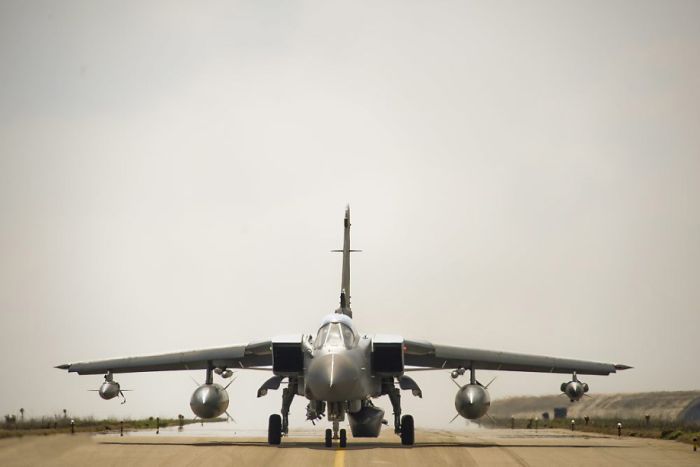|
|
Panavia Tornado Combat Aircraft
|
In an emergency deployment, the UK sent out a detachment of Blackburn Buccaneer aircraft equipped with the Pave Spike laser designator, allowing Tornado GR1s to drop precision guided weapons. A further crash programme in support of the sudden military action saw multiple GR1s outfitted with the TIALD laser designation system; author Claus-Christian Szejnmann declared that the TIALD pod enabled the GR1 to "achieve probably the most accurate bombing in the RAF's history". Although laser designation proved effective in the Gulf War, only 23 TIALD pods were purchased by 2000; shortages negatively impacted combat operations over Kosovo.
Following the initial phase of the war, the GR1s switched to medium level strike missions, typical targets for these strikes included munition depots and oil refining facilities. Only the reconnaissance Tornado GR1As continued to operate at the low-altitude high-speed profile throughout the war, the GR1A emerged unscathed despite the inherent danger posed by missions such as conducting pre-attack reconnaissance. In the war's aftermath, Britain maintained a military presence in the Gulf for many years, around half a dozen GR1s were based at Ali Al Salem airbase in Kuwait for operations over the southern no fly zone as part of Operation Southern Watch; another half a dozen GR1s participated in missions over Northern Iraq in Operation Provide Comfort.
In March 1993, a Mid-Life Upgrade (MLU) project of the Tornado was launched to upgrade the GR1/GR1A to GR4/GR4A standard. The Tornado GR4 made its operational debut in Operation Southern Watch; patrolling Iraq's southern airspace from bases in Kuwait. Both Tornado GR1s and GR4s based at Ali Al Salem, Kuwait, took part in coalition strikes at Iraq's military infrastructure during Operation Desert Fox in 1998. In December 1998, an Iraqi anti-aircraft battery fired six to eight missiles at a patrolling Tornado, the battery was later attacked in retaliation, no aircraft were lost during the incident. It was reported that during Desert Fox RAF Tornados had successfully destroyed 75% of allotted targets, and out of the 36 missions planned, 28 had been successfully completed.
The GR1 participated in the Kosovo War in 1999. The Tornados initially operated from RAF Bruggen, Germany; they later moved to Solenzara Air Base, Corsica. Experience from fighting in Kosovo led to the RAF procuring AGM-65 Maverick missiles and Enhanced Paveway smart bombs for the Tornado fleet. Following the Kosovo War, the GR1 was phased out as more aircraft were upgraded to GR4 standard. The final GR1 was upgraded and returned to the RAF on 10 June 2003.
|
|









